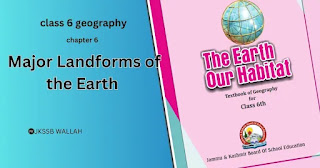class 6 geography chapter 6 questions and answers:Major Landforms of the Earth ,JKBOSE/State board
1. Answer the following questions briefly.
(a) What are the major landforms?
Ans: Major landforms include mountains, plateaus, and plains.
(b)What is the difference between a mountain and a plateau?
Ans: The difference between a mountain and a plateau is given below:
| Mountain | Plateau |
| A mountain is a natural elevation on the Earth’s surface. | A plateau is a flat and elevated landform. |
| A mountain is an elevated landform that is significantly taller than its surrounding area. | A plateau is a flat-topped landform that stands above the surrounding area. |
(c) What are the different types of mountains?
Ans: Three types of mountains:
Fold Mountains
Block Mountains
Volcanic Mountains.
(d) How are mountains useful to man?
Ans: Mountains are beneficial to humans in several ways:
1. Water Source: Mountains act as natural reservoirs, storing water that is vital for various purposes.
2. Water Utilization: Water from mountains is utilized for irrigation and hydroelectric power generation.
3. Agricultural Potential: River valleys and terraces in mountains offer fertile land for crop cultivation.
4. Biodiversity: Mountains are home to diverse plant and animal species, contributing to the planet’s biodiversity.
5. Recreational Activities: Mountains provide opportunities for recreational activities such as paragliding, hang gliding, river rafting, and skiing.
(e) How are plains formed?
Ans: When rivers flow through mountain slopes, they cause erosion of the mountains. The eroded materials, such as sediment, rocks, and clay, are carried by the river and deposited in the valleys. Over time, these deposited materials accumulate and contribute to the formation of plains.
(f) Why are the river plains thickly populated?
Ans: River plains are densely populated due to their fertile land and easy access to water resources, making transportation network construction easier.
(g) Why are mountains thinly populated?
Ans: Mountains are thinly populated due to harsh climates and limited arable land.
2. Tick the correct answers.
(a) The mountains differ from the hills in terms of
(i) elevation
(ii) slope
(iii) aspect
(b) Glaciers are found in
(i) the mountains
(ii) the plains
(iii) the plateaus
(c) The Deccan Plateau is located in
(i) Kenya
(ii) Australia
(iii) India
(d) The river Yangtze flows in
(i) South America
(ii) Australia
(iii) China
(e) An important mountain range of Europe is
(i) the Andes
(ii) the Alps
(iii) the Rockies
3. Fill in the blanks.
1. A ___________ is an unbroken flat or a low-level land.
2. The Himalayas and the Alps are examples of _______________types of mountains.
3. _____________ areas are rich in mineral deposits.
4. The _________________ is a line of mountains.
5. The ____________areas are most productive for farming.
Answer 3.
1. Plain
2. fold
3. Plateau
4. Range
5. plain

